
Copepods are a group of small crustaceans found in nearly every freshwater and saltwater habitat. Some species are planktonic, some are benthic, a number of species have parasitic phases, and some continental species may live in limnoterrestrial habitats and other wet terrestrial places, such as swamps, under leaf fall in wet forests, bogs, springs, ephemeral ponds, and puddles, damp moss, or water-filled recesses (phytotelmata) of plants such as bromeliads and pitcher plants. Many live underground in marine and freshwater caves, sinkholes, or stream beds. Copepods are sometimes used as biodiversity indicators.

Alexander von Nordmann was a 19th-century Finnish biologist, who contributed to zoology, parasitology, botany and paleontology.

Ergasilidae is a widespread family of copepods and comprises many species. The type genus is Ergasilus. With a few doubtful exceptions all ergasilids are parasitic on fishes.
Neutrodiaptomus is a genus of copepods in the family Diaptomidae. The Japanese endemic species N. formosus is listed as Data Deficient on the IUCN Red List. The genus Neutrodiaptomus contains the following species:
Bomolochidae is a family of copepods parasitic on marine fishes. Most species parasitize the gills of fish, but some species live in the nostrils or on the eyes of their hosts. The family contains just over 150 species from the following genera:

Ergasilus is a genus of copepod crustaceans occurring in both the ocean and fresh water, often called gill lice. The females are parasitic upon the gills of fishes. Being copepods, gill lice have a single median eye on their head. The second antennae are modified into prehensile pincers. Male gill lice are free-living.
Chondracanthidae is a family of parasitic copepods, usually found infecting the branchial chamber of demersal fishes. It comprises the following genera:
Clausiidae is a family of parasitic copepods of the suborder Poecilostomatoida, comprising the following genera:
Oleksandr Prokopovych Markevych, in English more often Aleksandr Prokofyevich Markevich was a Ukrainian zoologist, and a prolific helminthologist and copepodologist. He was professor and an Academician of the National Academy of Sciences of Ukraine.
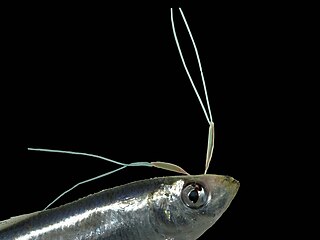
Pennellidae is a family of parasitic copepods. When anchored on a host, they have a portion of the body on the outside of the host, whereas the remaining anterior part of the parasite is hidden inside tissues of the host.

Lernaeopodidae is a family of parasitic copepods. The females are typically large and fleshy, and attach to the host permanently using a plug made of chitin called the bulla. The males cling on to the females using their antennae. They parasitize both marine and freshwater fish. Some lernaeopodids, including Clavella and Salmincola, can have negative impacts on fish in aquaculture.
Chondracanthus is a parasitic copepod genus in the family Chondracanthidae, containing the following species:
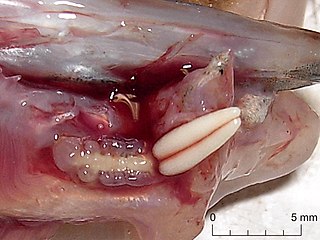
Acanthochondria is a genus of copepods, containing the following species:

Lepeophtheirus is a genus of sea louse. The best-known species is L. salmonis, the salmon louse. Other species include L. pectoralis, which uses flatfish as its host, particularly the European flounder, and is also the type species of the genus Lepeophtheirus.
Tracheliastes polycolpus is a species of copepod in the family Lernaeopodidae. It is an ectoparasite of a number of freshwater fish in Western Europe, including the beaked dace Leuciscus burdigalensis, the common dace Leuciscus leuciscus, and occasionally a few other fish species. The subspecies Tracheliastes polycolpus baicalensis has been described from Lake Baikal. The parasite attaches itself to the fins of the host, and lives on the mucus and epithelial cells of the host.
Cardiodectes is a genus of copepods in the family Pennellidae. Species are parasites of fish.

Peniculus is a genus of marine copepods in the family Pennellidae. They occur worldwide and typically parasitize coastal or epipelagic fish, with the exception of Peniculus hokutoae that was found parasitizing a mesopelagic myctophid, Symbolophorus evermanni.
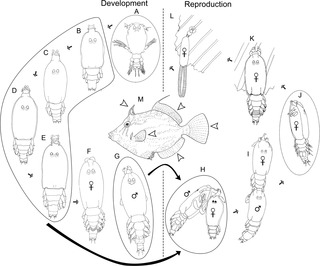
Peniculus minuticaudae is a species of parasitic pennellid copepod. It is known from the northeast Pacific Ocean. It was originally described in 1956, redescribed in 2012, and its complete life cycle has been elucidated on the cultured threadsail filefish, Stephanolepis cirrhifer in 2013.
Lernaeidae is a family of copepods belonging to the order Cyclopoida.
Ergasilus curticrus is a freshwater parasitic copepod named in 2015. Described from the Orinoco river basin, it was found solely to be hosted by individuals of the Characiform fish species Bryconops giacopinii. Of those located in South America, it is one of only five species in its genus to be found outside of Brazil.










